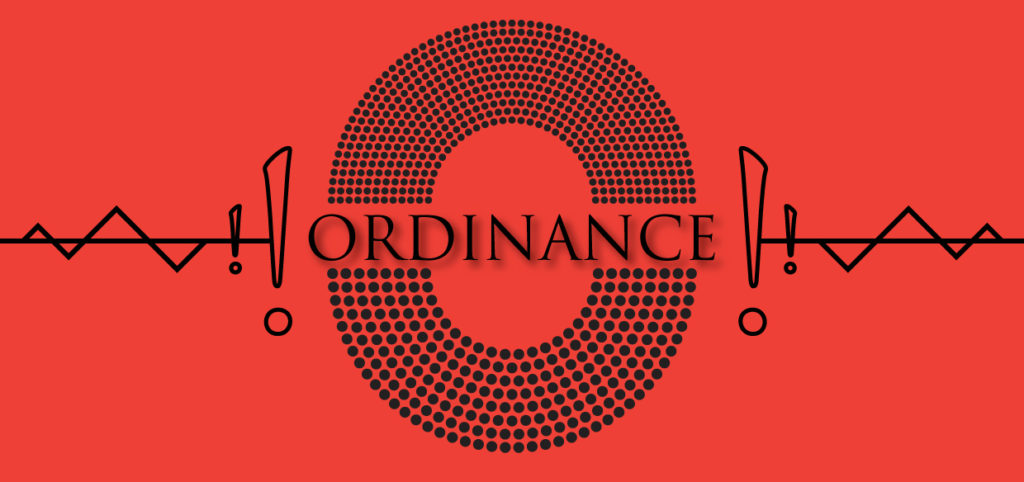What is an Ordinance in Indian Law

What is Ordinance in Indian Law
The ordinance is defined as an authoritative order in the Oxford dictionary. “A rule established by authority, a permanent rule of action, law or statute. In a more limited sense, the term is used to designate the enactments of the legislative body of a municipal corporation. The name has also been given to certain enactments, more general in their character than ordinary statutes, and serving as organic laws, yet not exactly to be called ‘constitutions’.”[1] It is a decree or law promulgated by a state or centre without the consultation of the legislature. Some examples of ordinances could be introducing a new taxing system or managing resources during the time of emergency. Effective execution of such ordinances can be only if it is not in conflict with any higher law such as constitutional provisions or national or state laws.
The president has the power to promulgate ordinances under article 123 of the Indian Constitution. Promulgating an ordinance is one of the most important powers that a president has, it not necessarily connected with an emergency but it can be issued by the president if he is convinced that an action is to be taken and that the parliament will not be able to enact on the same subject immediately but the circumstances render it necessary for him to take ‘immediate action’.[2]
What is the need for the ordinance?
An ordinance is an executive order issued by the president of India that holds the same force and effect as an act passed by the parliament. The president has the power to issue ordinances under Article 123 of the Indian Constitution. In reality, it is union cabinet that forwards proposals for issuing ordinances to the president who merely gives his assent.[3]
An ordinance can be issued only when both houses of parliament, Lok Sabha and Rajya Sabha, are not in session. It is meant as a last resort and not a tool to replace the power or functioning of parliament to assemble and consider the bill.[4]
An ordinance may be concerned with any subject that the Parliament has the power to legislate on and also has the same limitations as the parliament to legislate according to the distribution of powers between the union, state, and concurrent lists. There are three limitations with regard to the ordinance making the power of the executive. They are:[5]
- The president can only promulgate an Ordinance when either of the two houses of parliament is not in session.
- The president cannot promulgate an ordinance unless he is satisfied that there are circumstances that require taking ‘immediate action’,
- Ordinances must be approved by parliament with six weeks of reassembling or they shall cease to operate. They will also cease to operate in case resolutions disapproving the ordinance are passed by both the houses.
There also can be many instances that the ordinances are issued by the government for lack of consensus in parliament.[6] If there is a possibility of a bill not being passed in the current session of parliament, the government can take the ordinance route pending its approval by the parliament during a later session.[7] For instance, the ordinance on altering the land reforms act to make it easier to acquire land by the government for public purposes was promulgated fearing uncertainty over the passage of the bill in Rajya Sabha where the present government is not in a majority.
The validity of an ordinance
An ordinance has to be converted into legislation within 42 days (6 weeks) of commencement of the Parliament session, or else it will lapse. An ordinance can be re-promulgated only thrice. The governor of a state can also issue ordinances under Article 213 of the Constitution of India when the state legislative assembly is not in session. There have been various important discussions on the ordinance making the power of the President and Governor.[8]
How ordinance is turned into an act of parliament?
As already discussed before the ordinance is a temporary law or a temporary executive measure. It cannot replace the power and function of parliamentary process and has to be introduced as a bill in the parliament for it to be considered. Only when both the houses pass the bill it will turn into an act. It may also happen that one house may not pass the bill and disapproves it. In this case, a joint session of the parliament can be called to vote on the bill.[9]
[1] Black law dictionary.
[2] Article 123(1) of the Indian constitution.
[3] IAS Kracker.
[4] Dr. Durga Das Basu, Introduction to the Constitution of India, ed. 20th, 2011, LexisNexis.
[5] Ibid.
[6] Supra 3
[7] ibid
[8] Legal Service India
[9] Dr. Durga Das Basu, Introduction to the Constitution of India, ed. 20th, 2011, LexisNexis.
Try our Debt Resolution solutions today Request a Demo